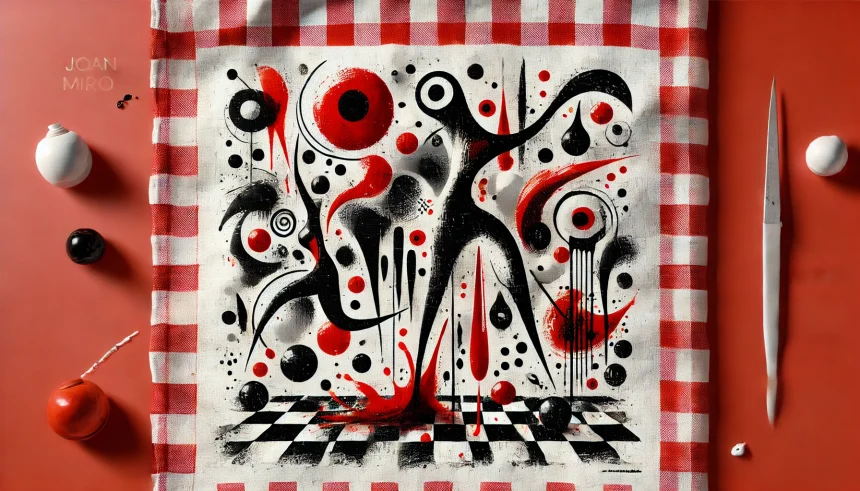Gingham fabric has been a well-known textile for centuries, recognized for its signature checkered pattern. It is usually made from cotton and is lightweight, making it a popular choice for clothing, home décor, and artistic experimentation. The structured grid-like design of gingham adds a sense of order and repetition.
Lithography is a unique printing method that allows artists to create detailed images on different surfaces. Traditionally, lithographs are printed on paper, but some artists, like Joan Miró, pushed the boundaries by using fabric. This technique gives the artwork a distinctive texture and depth, making it stand out from conventional prints.
Joan Miró was a Spanish painter and printmaker famous for his abstract and surrealist works. He often experimented with unusual materials and techniques, making his art both visually and conceptually unique. His use of gingham fabric in lithography was an innovative approach that blended fine art with textile patterns.
The “gingham fabric Miró lithograph on cloth” is a remarkable example of how art can evolve by merging traditional textiles with modern printing techniques. It reflects Miró’s ability to transform ordinary materials into extraordinary artistic creations.
Understanding Gingham Fabric
Gingham fabric is widely recognized for its checkerboard-like pattern, typically featuring two alternating colors. It is often used in making dresses, tablecloths, and upholstery due to its durability and easy maintenance. The simplicity of the pattern makes it a perfect background for artistic experimentation.
Historically, gingham fabric was first produced in Southeast Asia before gaining popularity in Europe and America. It became especially famous in fashion and household textiles. Over time, artists began using it as a creative surface for printing and painting.
One of the reasons gingham fabric is ideal for printing is its smooth yet firm texture. The tightly woven cotton fibers hold ink well, making it possible to create detailed prints. This is why it became a suitable medium for Miró’s lithographs.
Characteristics of gingham fabric:
- Made of cotton or a cotton blend
- Lightweight, breathable, and durable
- Repeating checkered pattern in two colors
- Ideal for printing and dyeing
The contrast between the strict geometric pattern of gingham fabric and Miró’s abstract forms adds a unique dynamic to his lithographs. This combination makes his work visually compelling and artistically innovative.
Joan Miró and His Artistic Influence
Joan Miró was born in Barcelona in 1893 and became one of the most influential surrealist artists of the 20th century. His work is known for its dreamlike compositions, playful shapes, and bold colors. He often incorporated symbols and spontaneous gestures, making his art feel lively and expressive.
Miró constantly experimented with different mediums, from painting and sculpture to printmaking. He believed that art should not be confined to traditional materials and sought new ways to express his creativity. This led him to explore printing techniques such as lithography on fabric.
His “gingham fabric Miró lithograph on cloth” is an example of how he merged different artistic styles. By using a pre-patterned textile, he challenged traditional notions of printmaking, making the background an active part of the artwork.
Miró’s signature artistic elements:
- Use of organic shapes and bold primary colors
- Influence from surrealism and abstract expressionism
- Combination of spontaneity and structured forms
- Experimentation with unconventional materials
By integrating lithography with fabric, Miró blurred the lines between fine art and everyday materials. His work encourages viewers to see textiles not just as functional objects but as a medium for artistic expression.
Miró’s Lithograph on Cloth
One of Miró’s most famous lithographs on fabric is “Le Lettre Aux Carreaux Rouges” (1969). This piece features a red-and-white gingham fabric as the base, with abstract symbols and fluid black lines printed over it. The structured background contrasts with his spontaneous shapes, creating a dynamic visual effect.
The gingham pattern acts as more than just a background—it becomes an integral part of the composition. Instead of working against the structured grid, Miró’s abstract forms interact with it, making the piece visually engaging. The layering of colors and lines adds movement and depth to the artwork.
Printing lithographs on fabric was not common at the time, making Miró’s work stand out. His choice of gingham fabric added texture and personality to the artwork, proving that ordinary materials could be transformed into high art.
This technique also reflected Miró’s belief that art should be accessible and engaging. By using fabric, a material associated with everyday life, he brought his surrealist vision into a more relatable and tangible form.
Techniques Used in Lithography on Fabric
Lithography is a printing process that relies on the natural repulsion of oil and water. The artist first draws an image onto a stone or metal plate using an oil-based medium. Water is then applied, preventing the ink from sticking to certain areas, ensuring only the intended design gets printed.
Printing on fabric, however, poses unique challenges compared to paper. The texture and absorbency of the fabric can affect the way ink is distributed. Special adjustments are needed to ensure clarity and longevity.
Key aspects of fabric lithography:
- Ink must be formulated to adhere to textiles without fading.
- Fabric needs to be treated or primed to hold the design well.
- The pressure used in printing must be carefully controlled.
Miró’s use of gingham fabric in lithography was a groundbreaking innovation. He embraced the imperfections and unpredictability of printing on fabric, which added depth and uniqueness to his work.
Impact on Modern Art and Design
Miró’s experimentation with fabric lithography has inspired many contemporary artists and designers. His approach encouraged others to think beyond traditional mediums, leading to more experimental and mixed-media artworks.
Textile-based art has since gained popularity, with artists using fabric for screen printing, digital printing, and hand-painted designs. Many fashion designers have also drawn inspiration from Miró’s ability to merge textiles and fine art.
His “gingham fabric Miró lithograph on cloth” serves as a reminder that art can exist in many forms. It has helped bridge the gap between fine art and everyday design, influencing not only painters but also textile designers and craftsmen.
By challenging conventional ideas of art, Miró proved that even a simple checkered fabric could become a masterpiece. His work remains a testament to the endless possibilities of artistic experimentation.
Conclusion
Joan Miró’s lithographs on gingham fabric are a brilliant example of creativity and innovation. By combining structured textiles with free-flowing abstract designs, he created artwork that is both visually striking and conceptually unique.
His choice of gingham fabric was not random—it provided a contrasting background that added depth to his surrealist compositions. The interaction between the printed shapes and the checkered pattern resulted in a fascinating blend of structure and spontaneity.
The “gingham fabric Miró lithograph on cloth” is not just a piece of art—it is an exploration of materials and their potential in fine art. It challenges traditional artistic boundaries and inspires future generations to experiment with different media.
Miró’s work continues to be celebrated for its originality, proving that innovation in art comes from thinking beyond traditional materials. His fabric lithographs remain an important part of his artistic legacy.
FAQs
What makes Miró’s lithographs on gingham fabric unique?
Miró’s work blends structured textile patterns with abstract art, creating a striking contrast between order and spontaneity.
Why did Miró choose gingham fabric for lithography?
The checkered pattern added a pre-existing structure, enhancing the interaction between his surrealist shapes and the textile’s grid.
How does lithography on fabric differ from paper?
Fabric absorbs ink differently, requiring special techniques to ensure clarity, durability, and vibrancy in the final print.
What is the significance of “Le Lettre Aux Carreaux Rouges” (1969)?
This artwork showcases Miró’s innovation in fabric lithography, using a red-and-white gingham base to contrast with his organic forms.
How did Miró’s fabric lithographs influence modern art?
His experiments inspired contemporary artists to explore textiles in printmaking, bridging fine art with everyday materials.

